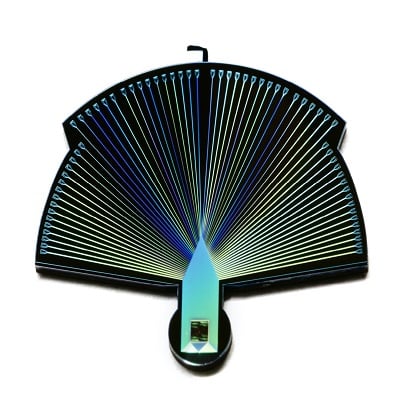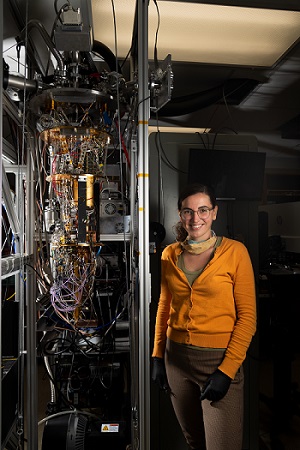NASA researchers have developed a detector that precisely measures single photons at high rates and could help to make high-speed quantum communication practical. The detector, created by researchers led by Matthew Shaw at NASA’s Jet Propulsion Laboratory, is called PEACOQ (performance-enhanced array for counting optical quanta). PEACOQ is made from 32 niobium nitride superconducting nanowires on a silicon chip. This nanowire architecture, said research team member Ioana Craiciu, a postdoctoral scholar, enables high count rates with high precision.
Quantum communication uses light at the single-photon level to send encoded quantum information such as encryption keys in quantum key distribution. Sending information at faster speeds requires a single-photon detector that can not only detect photons quickly, but also precisely measure their arrival times.
Further, speeding up quantum communication transmission rates requires a detector on the receiving end that can make quick measurements and exhibits a short dead time so that it can contend with a high rate of arriving photons.
“Although there are detectors that can measure photon arrival times with high precision, they struggle to keep up when the photons are arriving in quick succession and can miss some of the photons or get their arrival times wrong,” Craiciu said.

The PEACOQ detector is made of 32 niobium nitride superconducting nanowires on a silicon chip, which enables high count rates with high precision. Courtesy of Ryan Lannom, JPL-Caltech/NASA.
“There is not currently another detector that can count single photons this quickly with the same timing resolution,” Craiciu said.
The work builds upon technology developed for the NASA Deep Space Optical Communication project, which will be the first demonstration of free-space optical communication from interplanetary space.
The researcher designed the PEACOQ detector to precisely measure the arrival times of single photons even as they hit the detector at a high rate.
“It is also efficient — it doesn’t miss many of the photons,” Craiciu said.

Ioana Craiciu, postdoctoral scholar at JPL and co-author of this study, next to a cryostat used for testing superconducting nanowire detectors. Courtesy of Ryan Lannom, JPL-Caltech/NASA.
The nanowires that comprise PEACOQ are just 7.5 nm thick. The detector operates at approximately 1 Kelvin, or −458 °F, to facilitate superconducting. Under superconducting conditions, any photon that hits a wire has a good chance of being absorbed by that wire. Any absorbed photons create a hot spot that increases the wire’s electrical resistance in a detectable way. A computer and a time-to-digital converter are used to record when the resistance changed and therefore when a photon arrived at the detector.
When the detector measures a photon, it outputs an electric pulse. The time-to-digital converter measures the arrival time of the electrical pulse with a resolution below 100 ps, according to Craiciu. For PEACOQ, which has 32 channels, the team developed a new time-to-digital converter that can measure up to 128 channels at once with this timing resolution.
In a demonstration, the team used a custom setup to send light into a cryostat containing the detector and a chain of electronics to transmit the detector’s output signal out of the cryostat, amplify it, and record it. Because there are 32 nanowires, the researchers used 32 sets of each component, including 32 cables and 32 of each kind of amplifier.
“The rate at which it can measure photons was the highest we have seen,” Craiciu said.
Typically, quantum information being transmitted is set to a clock, with each piece of information encoded into one photon sent on a tick. How precisely the arrival time can be measured at the receiver determines how close together the ticks can be without making a mistake, thereby determining how quickly the information can be sent.
PEACOQ makes it practical to perform quantum communication with a clock frequency of 10 GHz.
The researchers are working to improve the detector, which is now about 80% efficient — meaning that about 20% of the photons hitting the detector are not measured. They plan to build a portable receiver unit that can be used for quantum communication experiments. It will contain several PEACOQ detectors along with optics, readout electronics, and a cryostat.
The research was published in Optica (www.doi.org/10.1364/OPTICA.478960).